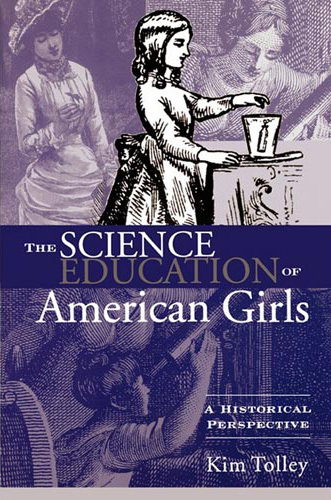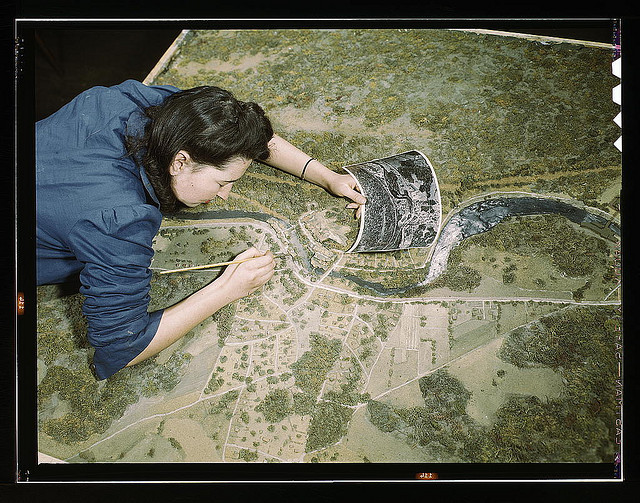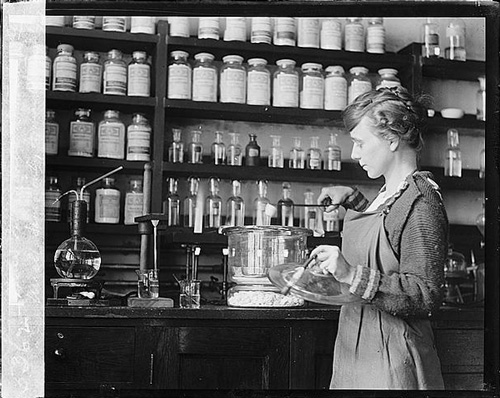From the ideals of ?republican motherhood? to a cure for ?the wayward attention of children.?
 Science education today is in crisis, troubled by a gaping gender gap and coupled with an equally appalling bias in popular perception. But it wasn?t always so: A mere 150 years ago, parents considered the physical sciences better-suited for girls than boys. In The Science Education of American Girls: A Historical Perspective (public library), education historian Kim Tolley traces how the curious reversal of gender norms ? much like the inversion of the pink-and-blue paradigm ? took place and how geography, more than any other discipline, opened the door to science for women.
Science education today is in crisis, troubled by a gaping gender gap and coupled with an equally appalling bias in popular perception. But it wasn?t always so: A mere 150 years ago, parents considered the physical sciences better-suited for girls than boys. In The Science Education of American Girls: A Historical Perspective (public library), education historian Kim Tolley traces how the curious reversal of gender norms ? much like the inversion of the pink-and-blue paradigm ? took place and how geography, more than any other discipline, opened the door to science for women.
?The revolution has been favorable to science in general, particularly to that of the geography of our own country,? wrote the Reverend Jedidiah Morse. In 1784, when Morse published his first geography textbook, he dedicated it ?To the Young Masters and Misses Throughout the United States,? signaling its appropriateness for females. Highly popular among boys and girls alike, Morse?s Geography Made Easy ran through numerous editions at least until 1820, when the twenty-third edition appeared. Geography was the first science to appear widely in girls? schoolbooks after the American Revolution.

Women were expected to be knowledgeable about scientific topics as they were entrusted with the early education of future citizens ? never mind they couldn?t yet vote and thus weren?t fully recognized as citizens themselves. At the same time, formal education was a rarity across genders ? in 1800, the average citizen was in school for a mere four months in his or her lifetime. In the postcolonial period, geography emerged not only as an area of academic study but also as a way of instilling in pupils national pride and patriotic values, essential in the architecture of the new country. Still, the rationale for teaching girls geography remained dreadfully rooted in the era?s gender norms:
Some educational reformers argued that knowledge of the sciences rendered women more interesting conversationalists and companions for their husbands. According to the well-known female educator Almira Hart Lincoln Phelps, scientific study would result ?in enlarging [women's] sphere of thought, rendering them more interesting companions to men of science, and better capable of instructing the young.? In general terms, educators often stressed the value of education in assisting women to bring up their children as virtuous and intelligent citizens. ? Americans promoted [geography] among girls because some contemporaries perceived women as playing a key role in developing scientific interest among children.
[?]
Jefferson believed the chief aim of a woman?s education was to train future generations to be effective citizens of the young Republic.
Once again, we see the utility of women in training and entertaining citizens, but not in being citizens. And yet, the study of geography was also promoted as a self-improvement means for women. Tolley writes:
Although some historians have emphasized the role of ?republican motherhood? as a rhetorical concept useful to advocates of female education, documentary sources indicate that the contemporaries just as frequently used justifications related o the self-improvement of young women. Arguments falling under the heading of ?self-improvement? can be categorized into three distinct groups: (1) moral improvement, comprising both general virtues and spiritual or religious growth; (2) mental improvement, constructed as the strengthening of the muscles of the mind, leading to improved intellectual prowess; and (3) psychological improvements, defined as the enhancement of personal well-being, increased fortitude, and the ability to provide oneself with intellectual resources leading to pleasure and happiness. ? During the eighteenth century, Americans came to view geography as a subject particularly capable of promoting moral and religious development.

'Miss Margaret D. Foster, Uncle Sam's only woman chemist,' Oct. 4, 1919 (Library of Congress)
Educators also saw geography as a may to bolster the mental discipline of American schoolchildren:
As citizens of a new political experiment, there were new requirements for young Americans. Faced with the task of building a nation on democratic principles, educational leaders argued that the development of an enlightened, rational citizenry was the key to a successful republic. The task of creating an educational system and a curriculum capable of molding children into enlightened citizens became a political imperative. The ability of a particular subject to promote mental discipline, to strengthen the faculties of the mind, was of utmost importance to educators. According to its advocates, to a grater degree than any other subject in the school curriculum, geography developed the student?s reasoning ability. Drawing maps could ?fix the wayward attention of children.? Altering the scale in drawings would ?exercise the power of judgment to a degree of which few studies are capable,? and learning geographical facts could ?exercise the memory.?
(Today, in the age of digitally rendered interactive maps and facts retrievable by Wikipedia searches rather than memory, one has to wonder how many of these alleged valuable skills are still being cultivated and celebrated.)

In addition to extolling its moral benefits, textbook-makers worked to make geography entertaining, hoping to spark a popular enthusiasm for science and frame it as not merely as useful, but also as enjoyable. Some textbook authors were particularly insistent upon engaging girls with the study of science, stressing the wider cultural benefits:
In the preface to their geography published in 1818, Vinson and Mann warned parents of the dangers of encouraging girls to decorate dolls and of allowing their boys too much time for idle play: ?The parent, who is contented merely with emulating a son by the spinning of a top ? or, a daughter by learning her to decorate a doll, to curl her hair ? must not be surprised nor disappointed if he discovers no higher, no purer emotions in their bosoms, and ideas in their minds??
Tolley concludes:
The introduction of geography into postcolonial schoolrooms marked an important shift in the way Americans began to think about the education of their daughters. Through geography, science became an acceptable part of the education of American girls. As the nineteenth century progressed, textbooks devoted exclusively to such subjects as botany, astronomy, and natural philosophy appeared in higher schools and diminished in geography textbooks, where they became redundant. Although scientific content declined in later geography texts, it did not disappear from the curriculum available to females. In the decades to come, increasing numbers of girls and young women would take up the study of science in their educational institutions.
For more on the capacity of maps and geographic curiosity to drive cultural change, pair The Science Education of American Girls with 100 diagrams that changed the world and how the cult of cartography got its start.
Donating = Loving
Bringing you (ad-free) Brain Pickings takes hundreds of hours each month. If you find any joy and stimulation here, please consider becoming a Supporting Member with a recurring monthly donation of your choosing, between a cup of tea and a good dinner:
You can also become a one-time patron with a single donation in any amount:
?
Source: http://www.brainpickings.org/index.php/2013/03/22/science-education-of-american-girls/
tom hardy British Open leaderboard Jessica Ghawi People Water Fred Willard Emmy nominations 2012 Ramadan 2012
 Brain Pickings has a free weekly newsletter. It comes out on Sundays and offers the week?s best articles. Here?s what to expect. Like? Sign up.
Brain Pickings has a free weekly newsletter. It comes out on Sundays and offers the week?s best articles. Here?s what to expect. Like? Sign up.
No comments:
Post a Comment
Note: Only a member of this blog may post a comment.